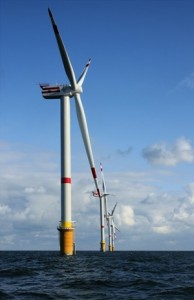The energy needs of the entire human population could potentially be met by converting wind energy to electricity by means of wind turbines. While offshore wind power resources are abundant, wind turbines are currently unable to provide steady power due to natural fluctuations in wind direction and strength. However, offshore wind power output can be made more consistent by choosing project development locations that take advantage of regional weather patterns and by connecting wind power generators with a shared power line, according to a paper coauthored by SoMAS Professor Brian Colle and published in the April 5 issue of the Proceedings of the National Academy of Sciences.
If offshore wind power is to displace significant amounts of carbon-emitting energy sources, the production rate of wind-generated electricity must be more steady. Dr. Colle and his colleagues–Willet Kempton, University of Delaware professor of marine policy and director of its Center for Carbon-free Power Integration; UD alumnus Felipe Pimenta, and UD research faculty member Dana Veron –demonstrated that thoughtful design of offshore wind power projects can make wind power more reliable by minimizing the impacts of local weather on power fluctuations.

Researchers analyzed hypothetical power output from five-megawatt offshore turbines similar to the one shown here off the coast of Belgium. Photo courtesy of Hans Hillewaert.
The researchers analyzed five years of wind observations from 11 monitoring stations along the U.S. East Coast from Florida to Maine. Based on wind speeds at each location, they estimated electrical power output from a hypothetical five-megawatt offshore turbine. After analyzing the patterns of wind energy among the stations along the coast, the team explored the seasonal effects on power output.
The researchers concluded that wind power transmission systems should be designed to consider large-scale meteorology, including the prevailing movement of high- and low-pressure systems.
Dr. Colle explained the ideal configuration. “A north-south transmission geometry fits nicely with the storm track that shifts northward or southward along the U.S. East Coast on a weekly or seasonal time scale,” he said. “Because then at any one time a high or low pressure system is likely to be producing wind (and thus power) somewhere along the coast.”
The researchers found that each hypothetical power generation site exhibited the expected ups and downs, but when they simulated a power line connecting them, the overall power output was smoothed so that maximum or minimum output was rare. Reducing the severity of wind power fluctuations would allow sufficient time for power suppliers to ramp up or down power production from other energy sources as needed. In the particular five-year period studied, the power output of the simulated grid never stopped completely.
No wind turbines are presently located in U.S. waters, although projects have been proposed off the coasts of several Atlantic states. This research could prove useful as project sites are selected and developed.




